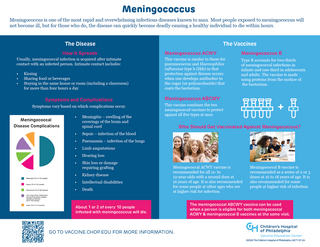Meningococcal: The Disease & Vaccines

Meningococcus is one of the most rapid and overwhelming infectious diseases known to man. About 10 to 15 people in 100 with meningitis caused by meningococcus will die from the infection. When infected people get a bloodstream infection (i.e., sepsis), the number of deaths rises to about 4 in 10. Death from sepsis can occur within 12 hours of the beginning of the illness.
View a full-size image of the infographic (PDF).
The disease
What is meningococcus?
The bacterium, Neisseria meningitidis, primarily targets children younger than 1 year of age. Because meningococcus is contagious, outbreaks can occur in childcare centers and schools. Cases also occur in high schools and on college campuses.
Meningococcus usually causes meningitis (inflammation of the lining of the brain) or sepsis (an infection of the bloodstream). Symptoms of meningitis include stiff neck, headache, fever and drowsiness. Symptoms of sepsis caused by meningococcus include fever, shock and coma. The disease is so rapid that a child can be perfectly well and, in a matter of only a few hours, be in a coma. For these reasons, meningococcal infections that occur in childcare centers, elementary schools or high schools often cause panic in the community. Every year, about 350 people in the United States are infected with meningococcus and about 50 die. Meningococcus can also cause pneumonia and arthritis.
Find out more about meningitis in this video discussion between two CHOP doctors.
Consequences of meningococcal infection occur in about 20 of every 100 survivors and can include:
- Limb amputation
- Skin grafting
- Hearing loss
- Seizures
- Kidney disease
- Intellectual disability
About 10 to 15 of every 100 people infected with meningococcus will die from the disease. Immunization is the most effective way to reduce the incidence of death and permanent sequelae caused by meningococcus.
How do you catch meningococcal infection?
Usually meningococcal infection is acquired after intimate contact with an infected person. Intimate contact includes kissing, sharing food or beverages, or staying in the same house or room (including a classroom) for more than four hours a day.
Because smoking disrupts the lining of the throat, people who smoke are at increased risk of some infections, including pneumococcus and meningococcus. Both of these vaccine-preventable diseases can cause meningitis.
The vaccine
How are the meningococcal vaccines made?
Two types of meningococcal vaccines are available. One has been available for several years and protects against four of the five types of meningococcus (A, C, Y, and W-135). The other version is newer and protects against the fifth type of meningococcus, type B.
Meningococcus A, C, Y and W-135 vaccine
This meningococcal vaccine is similar to those for pneumococcus and Haemophilus influenzae type b (Hib) in that protection against disease occurs when one develops antibodies to the sugar (or polysaccharide) that coats the bacterium.
In order for young children to make an immune response, the polysaccharide must first be attached to a harmless protein. (see "How Are Vaccines Made?"). The polysaccharide attached to the protein is known as a conjugate vaccine. There are three conjugated meningococcal vaccines commonly used in the U.S. instead of the earlier vaccine:
- Menactra® has been available since 2005 and can be given to people between 9 months and 55 years of age.
- Menveo® has been available since 2010 and can be used in people between 2 months and 55 years of age. A newer, so-called “one-vial version” became available in 2022; this version can only be given to people between 10 and 55 years of age. For those younger than 10 years of age, the older, “two-vial version” must be used. From an immunologic perspective, the two versions can be considered to be the same. They are made with the same ingredients and behave the same in terms of how well they work and their safety. However, healthcare providers will need to distinguish between them because of the different age groups that each can be given to and the fact the one-vial version is ready to administer, whereas the two-vial version requires providers to prepare the vaccine before administering it.
- MenQuadfi® has been available since 2020 and can be used in people 2 years of age and older.
In each of these vaccines, the polysaccharides from the surface of four of the five different types of meningococcal bacteria that cause disease were isolated individually and linked to a harmless protein. The four conjugated polysaccharides were then combined into a single shot, referred to by all four types – A, C, Y, and W-135.
Meningococcal B vaccine
Hib and pneumococcal vaccines have been easier to make than the meningococcal vaccine. The Hib vaccine was easier to make because there is only one type of Haemophilus influenzae that commonly causes severe disease in children (type b). The pneumococcal vaccine was easier to make than the meningococcal vaccine because, although there are about 90 different types of pneumococcus, most of the disease in children is caused by a limited number of known types. Current pneumococcal vaccines contain 13 to 20 types of polysaccharides — each linked to a harmless protein.
Although there are only five different types of meningococcus that commonly cause disease (types A, B, C, Y and W-135), it has been very difficult to make a vaccine that includes type B, and meningococcus type B accounts for two-thirds of meningococcal infections in infants and one-third of meningococcal infections in adolescents and adults. Two vaccines to prevent meningococcus type B were licensed for use in adolescents in 2015 — Bexsero® and Trumenba®. Both of these vaccines were made using proteins, not polysaccharides, that reside on the surface of the bacteria. Trumenba contains two proteins, and Bexsero contains four.
Who should get the meningococcal vaccine?
The A, C, Y, W-135 meningococcal vaccine is recommended for:
- Adolescents and teens 11 to 18 years old
- Children and adults without a spleen
- Children and adults who lack a particular group of serum proteins, called complement proteins, that help the body fight infection
- College freshmen living in dormitories
- People exposed to someone infected with meningococcus during an outbreak if the type of meningococcus is one contained in the vaccine (types A, C, Y or W-135)
- Children and adults who will be traveling to sub-Saharan Africa between December and June
- Military recruits
- Lab workers who work with the bacteria
The meningococcal B vaccine is recommended for:
- All 16- to 18-year-olds
- Those 18 to 23 years of age, who have not previously received it and could benefit
- People aged 10 years and older who have complement deficiencies, no spleen or a spleen that does not function
- Lab workers who work with the bacteria
- People exposed to someone infected with meningococcus type B during an outbreak, such as on a college campus
Does the meningococcal vaccine have side effects?
The meningococcal vaccines may cause pain or tenderness where the shot is given, but do not cause any serious side effects. Although a possible association with Guillain-Barré Syndrome (GBS) was investigated, no causal association was found.
Other questions you might have
Is it true that more than one type of infection can cause meningitis?
Yes. Everyone has heard it on the news ─ the story of a local student infected with meningitis. Such a report inevitably results in many questions and a great amount of concern and even fear among families with children in the affected school.
There are some important considerations when this happens. First, it is important to remember that meningitis refers to an infection that has reached the lining of the brain and spinal cord. Second, it can be caused by viruses or bacteria (hence the reference to viral meningitis or bacterial meningitis).
Viral meningitis, the most common type of meningitis, is often less severe than bacterial meningitis. Vaccine-preventable diseases that can cause viral meningitis include measles, mumps, chickenpox and influenza.
Most, but not all, cases of bacterial meningitis can be prevented by vaccination. The bacteria most often associated with meningitis include meningococcus, pneumococcus, and Haemophilus influenzae type B (often referred to as Hib). Fortunately, by the age of 2, most children are fully immunized against pneumococcus and Hib, and most adolescents are protected against meningococcus.
Should college students get the meningococcal vaccine?
The risk of meningococcal infection is highest in those younger than 1 year of age, and much lower in those between 4 and 15 years of age. At around 15 years of age the incidence of meningococcal disease again rises, although not nearly to the level that occurs in young children. However, as a result, there is again an increased risk of meningococcal infection during adolescence and young adulthood. In particular, college freshmen who live in dormitories are five times more likely to get a meningococcal infection as compared with those who live off campus or don't attend college. Therefore, both meningococcal vaccines are recommended for all college freshmen living in dormitories.
Although adolescents and young adults are less likely than infants to be infected, they are more likely to die from the infection; therefore, it is a good idea for all adolescents to be immunized.
Watch this short video to hear why college students should receive meningococcal vaccine.
Learn more about outbreaks of meningitis on college campuses by watching this short video, part of the series Talking About Vaccines with Dr. Paul Offit.
One of the children in my child's school got bacterial meningitis. Should my child get the meningococcal vaccine, take antibiotics, or do neither?
First, try to find out what bacteria caused the meningitis. This usually takes about 48 hours from the time that the diagnosis was first made. Remember, bacteria such as pneumococcus and Haemophilus influenzae type b (Hib) can also cause meningitis. If the bacterium was meningococcus, find out from public health officials whether it really was an outbreak of meningococcus. If so, your child should receive the meningococcal vaccine that contains the type of meningococcus involved in the outbreak.
In addition, antibiotics (such as rifampin, ceftriaxone or ciprofloxacin) should be used for all children who have come in close contact with someone who was infected. Close contact is defined as sharing a classroom for more than four hours a day, kissing or sharing food or beverages. Close contact in the week prior to the outbreak of meningococcus puts one at greatest risk of infection.
Relative risks and benefits
Do the benefits of the meningococcal vaccine outweigh its risks?
Each year about 350 people in the United States are infected with meningococcus and about 50 die. Some survivors will suffer permanent disabilities such as seizures, loss of limbs, kidney disease, deafness, skin grafting or intellectual disability. The meningococcal vaccines do not cause any severe reactions. Therefore, the benefits of meningococcal vaccination outweigh the risks.
Disease risks
- Meningitis (inflammation of the lining of the brain). Symptoms can include stiff neck, headache, fever and drowsiness
- Sepsis (infection of the bloodstream). Symptoms can include fever, shock and coma
- Survivors can suffer limb amputation, skin grafting, hearing loss, seizures, kidney disease and intellectual disability (20 of 100 people)
- Disease can be fatal (10 to 15 of 100 people)
Vaccine risks
- Pain or tenderness at the injection site
References
Plotkin SA, Orenstein W, Offit PA, and Edwards KM. Meningococcal capsular group A, C, W, and Y conjugate vaccines in Vaccines, 8th Edition, 2024, 664-689.
Plotkin SA, Orenstein W, Offit PA, and Edwards KM. Meningococcal vaccines directed at capsular group B in Vaccines, 8th Edition, 2024, 690-710.
Reviewed by Paul A. Offit, MD, on August 01, 2023
